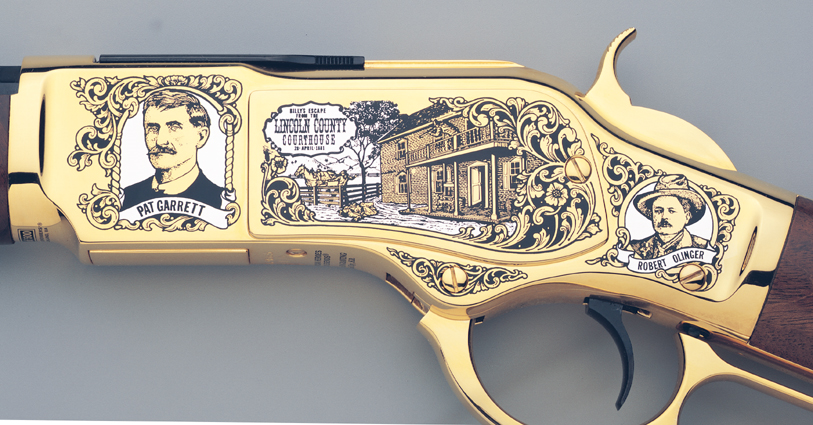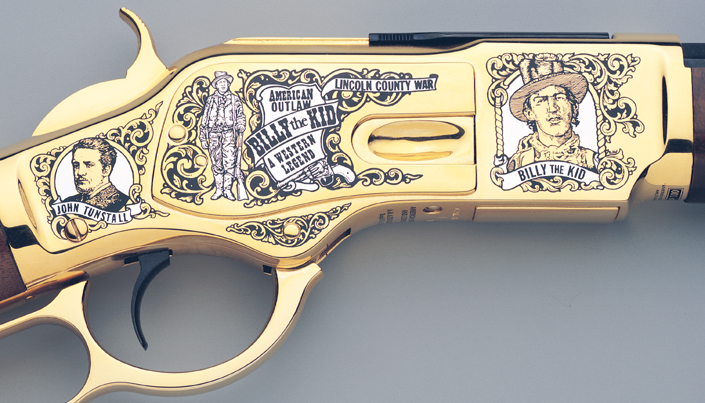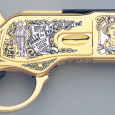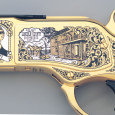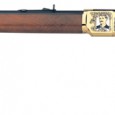THIS ISSUE IS CLOSED.
In remembrance of Billy the Kid and his place in the lore of the Old West, America Remembers presents the Billy the Kid Rifle.
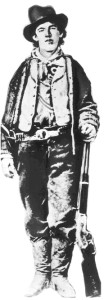 Billy the Kid is arguably the most famous outlaw in the history of the Old west. Shot by Pat Garrett when he was only 21, Billy the Kid’s reputation and legend only grew larger after his death. The one known image of William Bonney is a tintype that portrays him in mismatched cowboy duds, posing with a Winchester Model 1873 Rifle and a single-action Colt. Billy the Kid’s family moved to Silver City, New Mexico when Billy was fourteen. A possible prank gone badly at a Chinese Laundry where he worked sent Billy to jail from which he escaped, beginning a trend that would establish him as a wanted man. Supposedly, the Kid killed his first victim in the Camp Grant area of Arizona during a gunfight when he was around seventeen. Billy told his jailers that his opponent, who was much larger, was pummeling him, so he had to shoot the man in self-defense. He picked up the name Kid Antrim on his way out of town, which later evolved into the infamous title “Billy the Kid.”
Billy the Kid is arguably the most famous outlaw in the history of the Old west. Shot by Pat Garrett when he was only 21, Billy the Kid’s reputation and legend only grew larger after his death. The one known image of William Bonney is a tintype that portrays him in mismatched cowboy duds, posing with a Winchester Model 1873 Rifle and a single-action Colt. Billy the Kid’s family moved to Silver City, New Mexico when Billy was fourteen. A possible prank gone badly at a Chinese Laundry where he worked sent Billy to jail from which he escaped, beginning a trend that would establish him as a wanted man. Supposedly, the Kid killed his first victim in the Camp Grant area of Arizona during a gunfight when he was around seventeen. Billy told his jailers that his opponent, who was much larger, was pummeling him, so he had to shoot the man in self-defense. He picked up the name Kid Antrim on his way out of town, which later evolved into the infamous title “Billy the Kid.”
Once again free, Billy the Kid solidified his place opposite the law by joining a band of rustlers, whose thieving ways kept Billy on the run until he met an Englishman named John Tunstall. The wealthy businessman, who had established himself in ranching and real estate, took in Billy the Kid to help work on his ranch. Later, Tunstall became partners with Alexander McSween in building a general store in downtown Lincoln County.
John Tunstall became a mentor to Billy the Kid, providing him with a horse and saddle- the first time Billy had been aided by such generosity. The Kid grew appreciative and began to admire Mr. Tunstall in the few weeks he worked for him on a legitimate basis. Little did Billy the Kid know that powerful forces had begun to plot against Tunstall.
The Lincoln County War was brought on by the corruption that engulfed local government and businessmen, like James Dolan and Lawrence Murphy, who were rivals of Tunstall and his associates. Dolan and Murphy had attracted investors at every level in the county, who wished to see the partners do well. Having infiltrated the local business world of the scandalous county, Tunstall was treading on thin ice. Sheriff Brady sent a posse out to Tunstall’s ranch to discuss some charges. During this confrontation, John Tunstall was murdered. Billy the Kid saw the incident from a distance, but was helpless to make a difference against the band of killers.
Billy the Kid was now entrenched in the dirtier half of the Lincoln County War. The murder of his mentor drove Billy into a frenzy, and he partnered with some of the other hands from Tunstall’s ranch to form a vigilante group called “The Regulators.” They were a posse committed to bringing Tunstall’s murderers to justice.
The Regulators exchanged shots with A.L. “Buckshot” Roberts, a gunman for the Dolan-Murphy gang, while trying to serve him an arrest warrant. Many bullets found their mark, as both Roberts and Dave Brewer, a foreman from Tunstall’s ranch, fell dead. Billy the Kid, along with some others involved, was dissatisfied with the outcome of the fight. When the group returned to Lincoln, they shot Sheriff Brady in the streets of Lincoln.
Swift retribution followed the Kid’s actions. The newly appointed Sheriff Peppin cornered Billy the Kid and the Tunstall group in McSween’s house. With Billy the Kid’s reputation having grown, a siege bore down on the house that lasted for days. When the structure was eventually set on fire, the battle came to a climax with smoke and gunfire. Both McSween and Sheriff Peppin died in the fight, but Billy the Kid managed to scrape through unscathed.
The new territorial governor Lew Wallace, who was appointed by President Hayes to quiet things down, later tried to end the feuding by offering Billy the Kid a full pardon for all the wrongs he had perpetrated. The trade-off was that the Kid had to turn himself in and testify in another case. The plans did not unfold as Wallace had hoped. Local politics prohibited Billy from receiving any kind of official pardon, and the Kid left town to avoid any more trouble with the Dolan-Murphy group.
Later, in October of 1880, Billy’s former friend, Pat Garrett, became Sheriff of Lincoln County and began the steps of bringing Billy the Kid to justice. Before the close of that year, Sheriff Garrett tracked Billy and the Regulators to Stinking Springs where the gang was surrounded and surrendered. Garrett transported Billy to jail in Las Vegas, New Mexico, where he spent his time petitioning Governor Wallace to remember the promises of pardon he had made prior. However, Billy’s requests went unanswered, and he was convicted of the murder of Sheriff Brady.
Billy’s future uncertain, he decided to take matters into his own hands. He managed to escape jail again by slipping out of his handcuffs and overpowering the guard, J.W. Bell, before finishing him off with a shot from Bell’s own gun. Deputy Bob Olinger heard the noise and rushed to the courthouse, but Billy saw him coming and shot Olinger with a shotgun.
Billy the Kid was on the lam again with Garrett and his men hot on his trail. This time there would be no discussion of amnesty for the Kid. The double murders of the deputies sealed Billy’s fate in the eyes of the law for good. Unfortunately for the Kid, his old friend Pat Garrett stayed one-stop ahead of him. Garrett and his deputies were waiting for him at the home of Pete Maxwell, where Billy had been spending some of his evenings.
As the legend goes, Billy returned home late one evening and passed a pair of strangers by the threshold of the house. Though he was unaware, they were actually deputies that had come with Sheriff Garrett to find the Kid. Garrett had staked out the house earlier, and was already waiting inside. When the Kid stepped into the room, a couple of shots rang through the black bedroom. Once the smoke had cleared, Billy the Kid was dead.
Rumors swirled about his death; a lifetime of escapes and daring adventures, preceded rumors that Garrett had actually shot the wrong man or maybe never shot anyone at all. It is said that Billy the Kid is buried near Fort Sumner, but this issue, along with most statements made about the Kid’s life and death, have been argued time and again over the years. His legend has only increased as Billy the Kid has been painted as both a heinous murderer and a misrepresented vigilante. Even Pat Garrett, who cashed in on Billy the Kid’s fame by writing a biography about him, portrayed Billy as being a likeable kid, maltreated by the law. It seems at the end that the Kid’s greatest legacy was leaving few facts behind for his admirers to rely on.
His legend has grown, and it has even been reported that Billy the Kid murdered 21 people before he was killed (one for each year of his life) – even though most historians agree this number is much too high. The legend of Billy the Kid is as well-known as any of the legendary lives of America’s most famous outlaws and lawmen.
The Billy the Kid’s story has come to find a place in our hearts, and it is because of his enduring legend that America Remembers is proud to present the Billy the Kid Tribute Rifle. We’ve chosen the Model 1873 rifle as the most fitting tribute to the Kid because both the Model ‘73 and Billy the Kid are synonymous with the Wild West, and it is the rifle shown with Billy the Kid in the only documented photo of the Kid. Through this exclusive Tribute we have proudly brought together two icons of the Western frontier.
A Handsome Tribute to the Billy the Kid
Often called “the rifle that won the West,” the Model ‘73 has been admired for decades as an engineering landmark, representing light-weight utility and long-ranged power. This firearm was one of the most coveted rifles of its day, and was the ultimate prize for outlaws, lawmen, Indians, and settlers of the frontier.
Each Billy the Kid Tribute Rifle is a handsome working recreation of the immortal Winchester Model 1873 rifle produced for us by the master craftsmen of A. Uberti. The Billy the Kid Tribute Rifle is a fully functional, working firearm in .44-.40 caliber. The handsomely blued, 24-1/4 inch tapered octagonal barrel is complemented perfectly by the elegantly decorated receiver, along with the polished and gold decorated lever, hammer, trigger, buttplate, and forearm end cap. The focal point of the Tribute is the spectacular artwork features on the receiver, including a depiction of the legendary tintype depiction of Billy the Kid and his own Model 1873 Rifle. Craftsmen specifically commissioned for this project by America Remembers have magnificently captured the details of the handsome artwork that we have created for this historic Billy the Kid Tribute. All artwork is featured in a spectacular combination of 24-karat gold and nickel with blackened patinaed highlights to accent the details of the artwork.
Prominently featured on the left side of the receiver are portraits of Pat Garrett and Robert Olinger. Sheriff Pat Garrett will always be known as as the lawman who shot Billy the Kid, establishing his reputation as a legendary lawman. Deputy Olinger was the unlucky one to have met the Kid’s weapon when he ran into the courthouse during Billy’s last jailbreak. Featured in the center is a scene of Billy’s courthouse escape on April 28th, 1881, along with a banner identifying this landmark moment in time. Like the finest presentation firearms, detailed scrollwork elegantly frames both sides of the receiver’s artwork in 24-karat gold.
Prominently featured on the right side of the receiver is a portrait of Billy the Kid based on the only known image of the outlaw. Also featured is a portrait of John Tunstall, the English businessman who meant so much to Billy the Kid. In the center is a banner that reads “Billy the Kid” next to the full-length image of the Kid and his rifle based on the only known photograph of this legendary outlaw. The words “American Outlaw” and “A Western Legend” are also displayed as a Tribute to the Kid, while “Lincoln County War” trails over the firearm’s loading port.
An Exclusive Edition
Act now, and you can own a classic Western rifle capturing one of the most famous outlaws from the era of the Wild West. Only 500 of the Billy the Kid Tribute Rifles are being produced for this exclusive issue.
Each order will be promptly confirmed and we will arrange delivery of your working rifle through the licensed firearms dealer of your choice. If for any reason you are not fully satisfied with your Billy the Kid Tribute after your personal inspection, please return it in original, unfired condition within 30 days for a complete and courteous refund.
Legends live on with the retelling of their tales. The Billy the Kid Tribute Rifle captures an individual who blazed a trail through the Old West, securing his place in American History for all time. Billy the Kid will always be one of the best known outlaw legends of the Western era, and this Tribute is a wonderful way to ensure that his legend will continue to ride on and that his legacy in the history of the Western frontier will remain for generations to come.
Shipping Procedures
Since the “Billy the Kid Tribute Rifle” is a working Model 1873 rifle, we will arrange delivery through the licensed firearms dealer of your choice.
Order
I wish to reserve the “Billy the Kid Tribute Rifle,” a working Model 1873 rifle, at the current issue price of $2,395*. Each rifle is numbered within the edition limit of 500 and is accompanied by a Certificate of Authenticity. Thirty day return privilege.
Please charge my credit card a deposit of $195 per rifle. I will pay the balance at the rate of $100 per month, with no interest or carrying charge.
* All orders are subject to acceptance and credit verification prior to shipment. Sales tax is required in certain states and will be added. Shipping and handling will be added to each order. Virginia residents please add sales tax.





